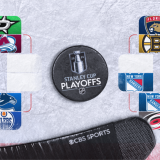When members of the 1980 U.S. Olympic Hockey Team finally stepped off the podium after receiving their gold medals 35 years ago Tuesday, they couldn’t have possibly known that the ice they were stepping down on had changed forever. For the next 35 years, hockey would evolve and grow through the country they had so triumphantly represented.
After completing the Miracle on Ice with a 4-3 victory over the Soviet Union, the Americans made sure it would never be forgotten by winning the gold medal two days later with a 4-2 comeback victory over Finland in their Olympic finale. It was an accomplishment that put hockey on front pages across the United States, and built fervor for the game that had never been seen before. The results were so unexpected that even USA Hockey – then known as the Amateur Hockey Association of the United States – didn’t anticipate they’d have anything to capitalize on.
“We didn’t know what hit us,” said Dave Ogrean, who handled public relations for Team USA in Lake Placid and was one of the organization’s few full-time employees. “The notion that we would actually come out of Lake Placid as Olympic champions in the manner that it happened is not necessarily something we had in our mind’s eye.
“We hoped for it, we wished it.”
As a result, AHAUS didn’t have a plan in place to capitalize on this monumental event and ensure that the game could expand throughout the country. Hockey was still very much a regional sport, almost exclusive to the upper Midwest and Northeast of the country.
The Miracle team’s roster included 12 players from the hockey hotbed of Minnesota, four from Massachusetts, two from Michigan and two from Wisconsin.
At the time, AHAUS had an estimated 136,370 members involved in amateur hockey throughout the country. According to QuantHockey.com, only 68 Americans saw any action in the NHL in the 1979-80 season, a mere 10.4 percent of the league’s players.
The Miracle on Ice presented an opportunity for growth, but at the time AHAUS didn’t quite have the power to capitalize on it.
“The organization was so small,” said Ogrean, who is now USA Hockey’s executive director. “We didn’t have seven people on the payroll in 1980. When we all of the sudden won this gold medal, opportunities started to appear with corporate sponsors and others. We were scrambling to take advantage of that.”
A lot of the increased interest in the game was up to the local hockey communities across the country to capitalize, but even then, the number of facilities available to
“The mechanisms to capitalize on growth weren’t in place like they are today, because we didn’t have the tools or the staff to drive them,” Ogrean recalled. “We accepted the inertia that came with the increased focus on the sport. The volunteers just opened their arms to accept more and more young people into the game.”
As a result, the game probably didn’t grow like it could immediately after 1980, but that was an important event to get the ball rolling. It also helped that the NHL started expanding even more around the same time.
One thing that was immediate was the notice the Americans’ victory in Lake Placid gave to their fellow U.S.-born players in the eyes of the NHL.
In 1979, 10 Americans were selected by the 21 NHL teams at the time over six rounds and 126 picks. In the 1980 draft, months after the Miracle on Ice, 31 Americans were selected in the expanded draft. Nineteen of those 31 came within the first 126 picks of the 1980 draft. That’s quite a jump.
“That next group of players saw us go play into the NHL and a lot of those younger talented players coming up started to develop their dreams,” said Mark Johnson, Team USA’s leading scorer in 1980, who also played 669 games in the NHL.
“Prior to 1980, there weren’t a lot of Americans in the league. A lot of people got an opportunity to watch us. It exposed a lot of younger players, and gave them some hope not only to play college and junior, but to play in the NHL.”
By 1986, the U.S. presence in the NHL had increased by 50 percent compared to the 1979-80 season.
But it still would take years for the United States to enjoy the widespread growth that has helped turn hockey into a truly national game.
Significant events would help mold the future of American hockey, and this time the rebranded USA Hockey and the entrepreneurs of America were ready to capitalize on the boom.
Wayne Gretzky getting traded to the Los Angeles Kings in 1988 was a massive event in not only NHL history, but the future of the game in the U.S. The league had gained popularity, Gretzky was its greatest celebrity and there was finally infrastructure and strategy to capitalize on that. Gretzky’s arrival helped spawn unprecedented growth of the game in California as rinks started being built to make the Golden State a hockey state.
According to USA Hockey’s membership statistics for California, hockey participation increased by 221.8 percent statewide between 1990 and 1996, which had a Kings trip to the Stanley Cup Final in the middle. Last season, California ranked seventh in the nation in terms of hockey players registered with USA Hockey with more than 25,000 skaters.
In the following years, the NHL would move south and spread out in the west. Teams in Dallas, Tampa Bay, South Florida, Denver, Phoenix, Anaheim and San Jose proved to be the great experiment for the NHL. Whether all of those teams have been financially successful or not, their impact on the game was immense.
Both Florida and Texas were at or near 12,000 hockey players last season.
Now there’s even more sophistication to growing the game as USA Hockey established a membership development department that strategizes how the game can grow further. In less than seven years, that department, along with a revolutionary "American Development Model" initiative have brought innovation to growing the game.
“Our strategy of growth is how do we introduce kids at [ages] 6, 7 and 8, primarily, to the game,” said Pat Kelleher, USA Hockey’s assistant executive director of membership development. “Our youth associations are set up to take kids at that level. Our strategy has stayed the course.”
The result of this strategy has been marked growth at the 8 & Under level, and increased retention rates at the older levels according to Kelleher.
In 2014-15, USA Hockey will eclipse 600,000 total members for the first time in its history, which includes players of all ages, coaches and officials. That’s a long way from 136,000 hearty souls in 1980.
According to Kelleher, the biggest barriers to further growth remain the same. Obviously, the cost of hockey is one that can be prohibitive to families, as is the time commitment often required. Biggest of all, however, is the lack of facilities to this day.
“In the boom markets of the 1990s, there was heavy facility development that went on,” Kelleher explained. “That just created more opportunities.”
Many of the players born out of that era are matriculating to the NHL and getting drafted at a far greater pace.
In more recent years, however, as the economy slowed, fewer rinks were built and that has made growth more difficult. But hockey participation is still growing despite the barrier of fewer opportunities available.
According to Kelleher, USA Hockey and its affiliates are trying to find ways to get more kids involved in the game and keeping them involved. Some of the efforts to lower cost have been philanthropic-based, like the OneGoal program that helps provide rental equipment for free and local programs providing entry-level discounts. USA Hockey has also hosted several wildly popular Try Hockey for Free days that often attracts over 10,000 kids per nationwide event. But after they break down the cost barrier, there’s another to combat, and that’s kids dropping out when the game is no longer fun.
That’s where the growth strategy gets even more sophisticated.
USA Hockey launched its American Development Model not long after the membership development department was conceptualized. The ADM creates a pyramid from youth hockey all the way up through a player’s career. The focus of those efforts puts emphasis on age-appropriate development that allows kids to improve, while also having fun. They also have found a way to help combat costs, by promoting cross-ice or half-ice hockey for the youngest kids.
That allows more kids on the ice at once and also shrinks the rink down to a more manageable level for 7- and 8-year-olds and slightly older, so that they can actually improve their game. The more kids improve, the more fun they tend to have and the better they feel about the game they’re playing. At least that is the theory and it's still mostly in its infancy. There's really no telling where things will go next.
When looking back at the primitive nature of the game in the United States in 1980, however, it’s remarkable how far it has come. That’s not to say there isn’t more to be done.
That gold medal in 1980 was the last won by a U.S. men’s team in the Olympics and the women’s team hasn’t won gold since women’s hockey’s debut at the Winter Olympics in 1998. An American-born player has never won either of the Art Ross Trophy as NHL scoring champion or the Hart Trophy as the league’s MVP. Americans still make up just 24.2 percent of the NHL in 2014-15, which is far better than it was in 1979-80, but doesn’t necessarily reflect the overall hockey growth of the country.
There is more work to be done, more growth to attain and glory to achieve – Olympics or otherwise – but the game continues to grow while standing on the shoulders of the 20 American college kids who created the miracle that has allowed for so many more.











